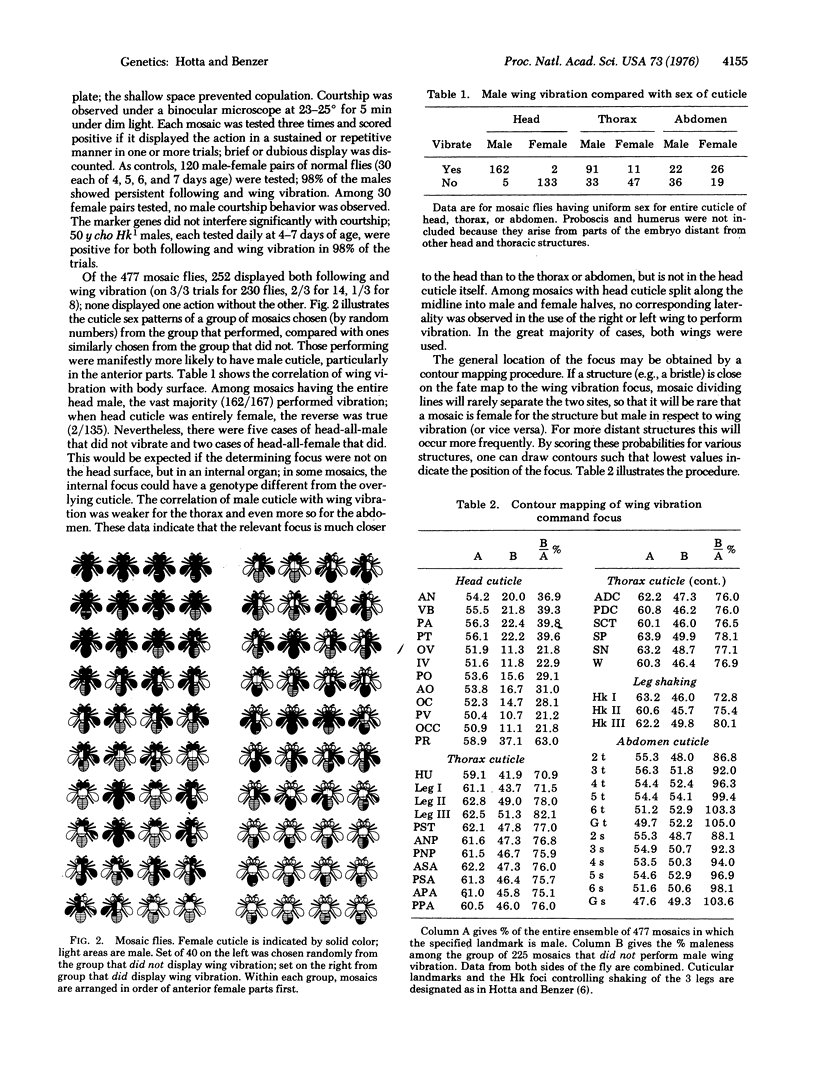Abstract
Mosaic fate mapping is used to locate the foci determining sex-specific steps in the mating behavior of Drosophila. Male performance of following females and displaying wing vibration toward them requires that a focus inside the head be constituted of male tissue, regardless of the sex of the head sense organs, the legs, the wings, or the thoracic ganglion. For attempted copulation to occur, a second focus in the thoracic region must also be male. Courtship by males is induced by a posteriorly located focus in the female, but an anterior female focus determines receptivity to attempted copulation. The interplay of male and female foci in the complex behavioral sequence is delineated.
Full text
PDF




Selected References
These references are in PubMed. This may not be the complete list of references from this article.
- Clark A. M., Egen R. C. Behavior of gynandromorphs of the wasp Habrobracon juglandis. Dev Biol. 1975 Aug;45(2):251–259. doi: 10.1016/0012-1606(75)90064-0. [DOI] [PubMed] [Google Scholar]
- Garcia-Bellido A., Merriam J. R. Cell lineage of the imaginal discs in Drosophila gynandromorphs. J Exp Zool. 1969 Jan;170(1):61–75. doi: 10.1002/jez.1401700106. [DOI] [PubMed] [Google Scholar]
- Hinton C W. The Behavior of an Unstable Ring Chromosome of Drosophila Melanogaster. Genetics. 1955 Nov;40(6):951–961. doi: 10.1093/genetics/40.6.951. [DOI] [PMC free article] [PubMed] [Google Scholar]
- Hinton H. E. Insect eggshells. Sci Am. 1970 Aug;223(2):84–91. doi: 10.1038/scientificamerican0870-84. [DOI] [PubMed] [Google Scholar]
- Hotta Y., Benzer S. Mapping of behaviour in Drosophila mosaics. Nature. 1972 Dec 29;240(5383):527–535. doi: 10.1038/240527a0. [DOI] [PubMed] [Google Scholar]
- Ikeda K., Kaplan W. D. Unilaterally patterned neural activity of gynandromorphs, mosaic for a neurological mutant of Drosophila melanogaster. Proc Natl Acad Sci U S A. 1970 Nov;67(3):1480–1487. doi: 10.1073/pnas.67.3.1480. [DOI] [PMC free article] [PubMed] [Google Scholar]
- Kankel D. R., Hall J. C. Fate mapping of nervous system and other internal tissues in genetic mosaics of Drosophila melanogaster. Dev Biol. 1976 Jan;48(1):1–24. doi: 10.1016/0012-1606(76)90041-5. [DOI] [PubMed] [Google Scholar]
- Merriam J. R., Lange K. Maximum likelihood estimates for fate map locations of behavior in Drosophila. Dev Biol. 1974 May;38(1):196–201. doi: 10.1016/0012-1606(74)90271-1. [DOI] [PubMed] [Google Scholar]
- Nissani M. A new behavioral bioassay for an analysis of sexual attraction and pheromones in insects. J Exp Zool. 1975 May;192(2):271–275. doi: 10.1002/jez.1401920217. [DOI] [PubMed] [Google Scholar]
- WIERSMA C. A., IKEDA K. INTERNEURONS COMMANDING SWIMMERET MOVEMENTS IN THE CRAYFISH, PROCAMBARUS CLARKI (GIRARD). Comp Biochem Physiol. 1964 Aug;12:509–525. doi: 10.1016/0010-406x(64)90153-7. [DOI] [PubMed] [Google Scholar]


